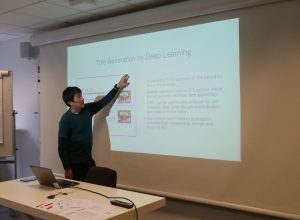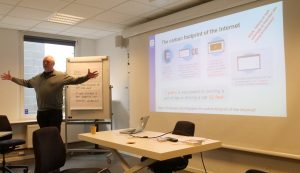Media Labs Days Copenhagen: how automation is changing the news
Media innovators from Canada, Japan and across Europe were welcomed to the Danish School of Media and Journalism (DMJX) to talk automation at GAMI’s fifth Media Lab Day.
Nikolaj Christensen, chief innovation consultant at DMJX, said the school, founded in 1946, remained focussed on “collecting knowledge, developing knowledge and sharing knowledge”, a perfect host for this global innovation network.
Andreas Marckmann, a fellow at the University of Southern Denmark and head of news at Fagbladet Journalisten, kicked off with a talk about his time spent researching automation in news.
In an upcoming book, he goes in-depth on what he found from 60 interviews with innovators from Denmark, Europe and the US. Of course, automation is already used widely in finance, sports and real-estate news, he explained. “Much of this is template-based and you can make tons of stories. But there’s a limitation – it takes work to programme it and there are questions around how good it can get, how much can it do.”
One such platform for automated reporting, IC Robotic, was demoed by the Danish startup’s CEO Marc Aas Nilsson. “It creates an article in 0.06 seconds – which means it’s able to produce a massive amount. It can create articles on all football games around the world. But there’s a problem with uniqueness – although it creates unique content, you can see patterns. It’s strictly fact-based, it doesn’t have flair.”
“A key question I have is – do media values apply to AI?” Marckmann asked. “Should we byline stories written by robots? What if 40 per cent of your stories are written by robots? What if the frontpage is ordered by robots? Who’s responsible when things go wrong? That’s an even more interesting question when it’s half a year after something is published.
“I came across a case where a robot journalist had got the result of a football match wrong and it was printed in a football newspaper. Of course, the editor is responsible. But who do they call? The sports editor? The robot people?

Andreas Marckmann, fellow at the University of Southern Denmark and head of news at Fagbladet Journalisten
“Bloomberg produces lots of financial news that is written by robots and only read by robots, who automatically sell and buy based on the information produced. Imagine if you hacked that and destroyed the stock of a company. And, should we offer our readers the opportunity to say ‘no’ to robots?”
Gordon Edall, head of labs at the Globe and Mail in Canada, explained how his 175-year-old publication, where 99 per cent of its stories are now curated algorithmically, is using automation to stay on top.
“We’re still an incredibly mission-driven organisation and we go to work every day knowing that we exist to build a better Canada,” he said. “It’s a thriving business that can continue to be ambitious and one of the ways we do that is by learning to tap into data.”
After several years using its lab to support staff with small amounts of money and time away from their desks to “think differently”, where some projects “saved us money, some made us money”, Edall has just unveiled its first commercial product. “Sophi represents a $10 million investment in newsroom analytics, enabling us to predict how valuable a story is going to be, manage paywalls and more.”

Hiroto Nakajima, chief scientist at Nikkei Innovation Lab
In Japan, Hiroto Nakajima, chief scientist at Nikkei’s Innovation Lab, which owns the UK’s Financial Times, told us how they use AI to generate and optimise headlines, as well as for every-day video news production. At Nikkei, 120 news videos are created each hour for three national TV stations… all presented and narrated by an avatar.
Karen Westman Hertz, market lead at Microsoft News in Denmark, used her talk to highlight how the tech giant has become more focussed on helping journalists. “Through the Microsoft News Lab, which launched last year, we’ve been trying to understand how our current technologies can help media companies, all based on the needs of media partners.”
One example, from the hearing of supreme court justice nominee Brett Kavanaugh, used Microsoft Azure to open up one single 75GB PDF of evidence so it could be properly interrogated. “That’s resulted in us launching the Insights and Discovery Accelerator (IDA), which helps journalists organise unstructured data, convert documents using OCR and even search for meaning in documents.”

Karen Westman Hertz, Microsoft News in Denmark, joining a media innovation workshop led by the University of Central Lancashire
The lab’s latest project, with The Atlantic, has involved scanning in its old archives so they can be used in its latest writing. Microsoft is also doing ‘robot audio’, now-indistinguishable from human voice. “Neural optimisation lets us improve the voice automatically,” Westman Hertz said.
“You’re all using AI every day,” Ole Kjeldsen, national director of technology and security, Microsoft Denmark, reminded the audience on day two. “If your bag arrives quickly at the airport – that’s AI. And video surveillance identifies abandoned bags. ‘Who did we see with this bag last?’.”
He showed examples of AI helping children with dyslexia learn how to read and doctors using AI to help them recognise cancerous tumours. “If you ask people, most will say they want a doctor to spot their tumour. AI is more accurate. But we’re still missing an open dialogue on the ethics of how we use AI.”
Perhaps with this kind of knowledge in mind, Martin Holmberg and Jenny Wiik from Sweden’s Lindholmen Science Park told us they have been given a “mission from government to create a national centre of applied AI and research”, launched in February 2019. They’ll be working on a news media and AI pilot until summer 2021.
“Things like this can only be done if you use the cloud,” Kjeldsen added. “Which is essentially just a huge data center. Microsoft now has 146 around the globe and is building two new ones a year, each the size of 20 to 25 football fields. It costs us $15 billion a year to build and maintain them.”
Other speakers included Soenke Schierer, product owner at HHLab, part of NOZ Digital, which owns 37 local newspaper brands in north Germany, who talked more generally about how his lab works. “We have a clear mission from our company – do not work on or think about existing products or existing markets. Do not think about money. Our team is 50 per cent journalists, so one of our main ways to the product is interviews – to give us insights into problems, needs, potential new users – to find out what’s not working.”
Echoing the success seen at other publishers, Swantje Fischenbeck, innovation manager at Der Spiegel, revealed that in 2020 the German magazine would be opening its own innovation lab. “We started ‘rebranding innovation’ in 2018, where we were doing ‘guerilla marketing’, literally painting innovation projects green so people could see them. We’re not doing innovation for the company or for the people working in the company, it’s with people in the company.”

Andrew Perkis, professor at the Norwegian University of Science and Technology
The event closed with Andrew Perkis, professor at the Norwegian University of Science and Technology (NTNU), asking us all to think more about how much energy all of this activity uses. He highlighted some of the latest data on the carbon footprint of digital media – with just one Google search estimated to be equivalent to boiling a kettle or driving your car 52 feet. “Do media owners ever ask us if we’d like to stream videos when using their website?”
As the world starts to make the changes needed to prevent the disastrous climate change anticipated by the Intergovernmental Panel on Climate Change if we do nothing, what will next-generation, ‘green’ media look like?
The Media Labs Day on 27 and 28 February 2020 in Copenhagen was the ffifth live event connected to our ongoing Media Innovation Mapping project. Read about the 50+ Media Labs we have covered so far and contact us to share your story.
